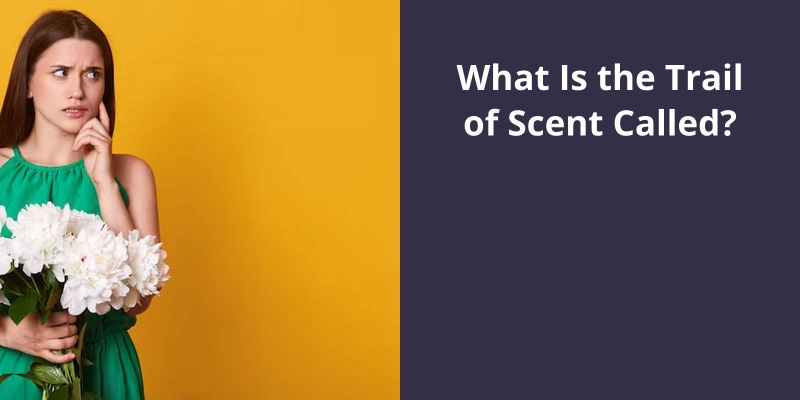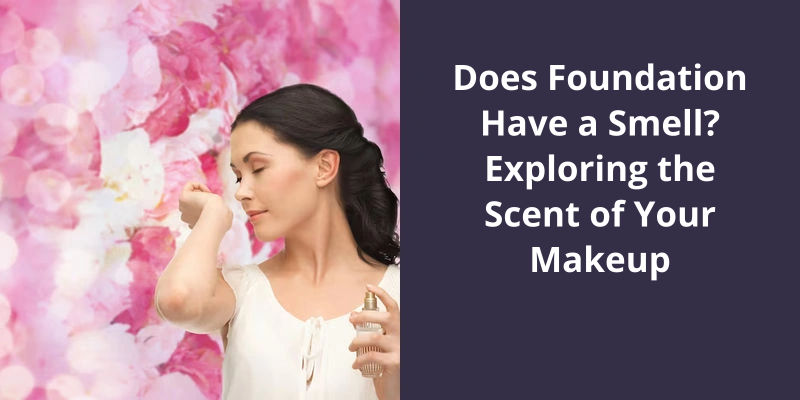The trail of scent is often referred to as the fragrance trail or “sillage.” Sillage, a term that originated from the French word for “wake,” is used in perfumery to describe the scented trail left by the wearer of a perfume. It specifically pertains to how the fragrance disperses from the body, creating an aura or trail of scent noticeable to others as you pass by. The strength and reach of this trail depend on various factors, including the ingredients of the perfume, the concentration, and how it reacts with the wearer’s body chemistry.

What Is the Name of a Perfume Trail?
Sillage, a French term pronounced as [sijaʒ], is the name given to the captivating and enchanting trail left by a perfume as it’s worn on the skin. Derived from the French word for “wake,” sillage perfectly encapsulates the phenomenon of how a fragrance disperses and lingers in the air, following the movements of the wearer.
When a person moves while wearing perfume, the sillage occurs as the fragrance diffuses gracefully behind them. It’s like a beautiful dance, where the scent paints an invisible path, leaving a lasting impression on everyone who catches a whiff. This captivating trail isn’t just limited to the immediate vicinity of the wearer but can extend further, enticing those who come in contact with it.
Much like an artistic signature, sillage provides a unique olfactory experience that sets apart each fragrance. Some perfumes have a more pronounced and intense sillage, leaving a powerful and alluring trail in their wake. Others may have a more delicate and subtle sillage, evoking a sense of mystery and intrigue.
It goes beyond being a mere scent and encompasses the essence of how a fragrance diffuses and captivates those around the wearer.
Perfumes, often referred to as fragrances, captivate our sense of smell with their pleasant and delightful compositions. These exquisite concoctions of scents have the power to transport us to different worlds, evoke memories, and enhance our overall experience. But what exactly gives perfumes their distinct aroma? Let’s explore the fascinating world of fragrance composition and learn more about the captivating art of perfumery.
What Is a Perfume Smell Called?
A fragrance is a smell, usually a pleasant or sweet smell, that’s created by combining various aromatic ingredients. When these ingredients are blended together in a specific ratio and composition, they create a unique scent that’s often referred to as a perfume. Perfumes have been used for centuries to enhance personal grooming rituals, express individuality, and evoke emotions.
The trail of scent left behind by a perfume as it lingers in the air is often called the sillage. Sillage refers to the projection and longevity of a fragrance, as well as the way it fills a space.
Another term related to the scent of perfumes is the top, middle, and base notes. These terms describe the different stages of a fragrances development on the skin. The top notes are the initial scents that are detected upon application, often light and refreshing. The middle notes, also known as heart notes, emerge after the top notes fade and form the main body of the fragrance. Finally, the base notes are the long-lasting scents that remain on the skin once the perfume has fully dried down.
Perfume smells are also referred to as olfactory compositions. Perfumers use a wide range of natural and synthetic ingredients, such as flowers, fruits, spices, woods, and musks, to create complex and multi-dimensional olfactory experiences.
The term “perfume smell” encompasses various aspects, including the sillage or trail of scent, the different stages of fragrance development (top, middle, and base notes), and the overall olfactory composition.
Perfume and Psychology: Explore the Psychological and Emotional Effects of Perfumes, Including the Influence of Scent on Mood, Memory, and Attraction.
- Perfume and it’s impact on mood
- The role of scent in triggering memories
- How perfumes can influence attraction
- The psychology behind fragrance preferences
- The emotional effects of wearing different types of perfumes
- The link between scent and relaxation
- The use of perfume in therapeutic settings
- The subconscious associations created by specific fragrances
- Exploring the cultural significance of perfumes
- The psychology of fragrance marketing and advertising
Olfactory art, also known as scent art, encompasses a unique form of artistic expression that revolves around the use of scents as it’s medium. This intriguing genre goes beyond just perfumes and encompasses various applications of scent to create a multisensory experience for the audience. Through the masterful manipulation of fragrance, olfactory artists tap into a realm where emotions, memories, and imagination intertwine, thus transforming our perception of art.
What Is the Art of Fragrance Called?
The art of fragrance is known as olfactory art. It’s a unique and captivating art form that utilizes scents as it’s medium of expression. It explores the powerful connection between our sense of smell and our emotions, memory, and perception of the world.
Fragrance compositions are carefully crafted using a wide range of raw materials, including natural and synthetic ingredients, to evoke specific emotions, trigger memories, or transport the audience to different places and times. The artistry lies not only in the creation of the scent itself, but also in the ability to convey a narrative or concept through the olfactory medium.
Through the art of fragrance, artists and perfumers have the opportunity to challenge traditional notions of art and explore new dimensions of creativity.
The History and Evolution of Fragrance as an Art Form
The history of fragrance as an art form can be traced back thousands of years.
Throughout ancient civilizations, individuals would burn incense and herbs to create pleasing scents.
The Egyptians played a significant role in refining the art of perfumery, using fragrant oils and resins in religious ceremonies and personal grooming.
In ancient Greece and Rome, perfumes became a symbol of status and luxury, with unique scents being created for different occasions.
During the Middle Ages, fragrance lost popularity due to religious and cultural beliefs, but it made a comeback during the Renaissance.
The Renaissance period saw the rise of perfume houses and the use of natural ingredients like flowers, spices, and musk.
In the 19th century, the discovery of synthetic fragrances revolutionized the perfume industry and led to the creation of new and exciting scents.
Today, fragrance is considered a form of art and self-expression, with perfumers meticulously crafting unique compositions of top, middle, and base notes to create evocative experiences for the wearer and those around them.
The trail of scent left behind by a fragrance is called it’s sillage.
This term refers to the lingering fragrance that remains in the air after someone has passed by.
The sillage of a fragrance can vary depending on factors such as the concentration and ingredients used.
Understanding the history and evolution of fragrance as an art form helps us appreciate the complexity and beauty behind these captivating scents.
Source: Olfactory art – Wikipedia
However, there’s another term often used to describe a delightful scent that may be less commonly known. This term is “perfumed.” Perfumed is often used to describe something that’s been intentionally imbued with an alluring fragrance, such as perfumes or scented lotions. It implies a deliberate effort to create a pleasant scent, rather than simply a naturally occurring one. So, while fragrant may refer to naturally sweet or agreeable odors, perfumed specifically highlights the presence of an intentional and carefully crafted scent.
What Is Beautiful Scent Called?
What’s the trail of scent called? The answer to this question lies in the realm of olfactory sensations. The beautiful scent is often referred to as fragrant, a term that encapsulates the essence of delightful smells.
Aromatic is one such synonym. It suggests a strong and pleasant smell, often associated with herbs, spices, or essential oils. Aromatic scents can evoke a sense of relaxation, invigorating the senses with their distinct notes. They’ve the power to transport us to different places and awaken our olfactory memories.
Odorous is another word that describes scents. It refers to smells that have a characteristic odor, which can vary from pleasant to pungent. Odorous scents can be found in a wide range of sources, from flowers and fruits to less appealing substances. While the term may encompass a broader spectrum of smells, it still denotes the ability to emit an odor that can be detected by the nose.
Redolent is a synonym that signifies the presence of a particular smell or fragrance. It’s often associated with memories or associations, as certain scents have the power to evoke emotions and transport us back in time. Redolent scents are imbued with a lingering quality, leaving a lasting impression on our olfactory senses.
However, there are other synonyms such as aromatic, odorous, and redolent that capture the essence of delightful smells. Whether it’s the sweet aroma of flowers or the enticing allure of spices, these scents have the power to enhance our sensory experiences and evoke powerful emotions. So next time you encounter a captivating fragrance, you can appreciate the many nuances of it’s olfactory journey.
A fragrance pyramid, also known as a perfume pyramid, is an olfactory concept that allows us to visualize the composition of a fragrance. Unlike a traditional pyramid, this concept has three layers, each representing a different category of scents. At the very top of the pyramid, we’ve the top notes, which are the initial scents we experience when we first smell a perfume. Moving down a layer, we find the heart notes, which emerge as the top notes fade away. Finally, at the base of the pyramid, we’ve the essential base notes, which linger on our skin long after the fragrance has settled. This pyramid shape reflects the way a perfume unfolds and evolves throughout the day.
What Is a Fragrance Pyramid?
A fragrance pyramid, also known as a perfume pyramid, is a visual representation of the composition of a fragrance. It’s based on the olfactory concept of how we perceive scents. The pyramid is divided into three distinct layers, each representing different aspects of the fragrance.
At the top of the pyramid, we’ve the top notes. These are the initial impressions that we get when we first smell a fragrance. They’re typically light, fresh, and evaporate quickly. Examples of top notes include citrus fruits, green leaves, and spices. They’re responsible for capturing our attention and making a strong first impression.
The middle layer of the pyramid contains the heart notes. These notes are the main body of the fragrance and develop just after the top notes evaporate. They’re often floral or fruity scents, and they last longer than the top notes. Heart notes give the fragrance it’s character and define it’s personality. They’re the heart and soul of the fragrance.
These are the longest-lasting and most powerful scents in the fragrance. They typically include woody, musky, or oriental notes. Base notes are responsible for providing depth and stability to the fragrance. They emerge slowly and become more noticeable as the fragrance dries down.
When we first apply a perfume, we’re immediately hit with the top notes, giving us an initial burst of scent. Finally, the fragrance settles into the base notes, which linger on the skin for hours, creating a trail of scent.
Consumers can use it to understand how a fragrance will evolve throughout the day and make a better-informed decision when purchasing perfumes. So, next time you explore a new fragrance, keep the fragrance pyramid in mind, and let the different layers take you on a scented journey.
Conclusion
This enchanting phenomenon is beautifully encapsulated by the French word "sillage", evoking images of a ship gracefully leaving it’s mark on the water. Much like the wake of a ship, different scents create varied levels of impact – with heavier fragrances commanding attention and lighter ones offering a delicate whisper. Sillage is the intangible essence that creates a lasting impression, allowing the artistry and allure of perfumery to transcend time and space.





